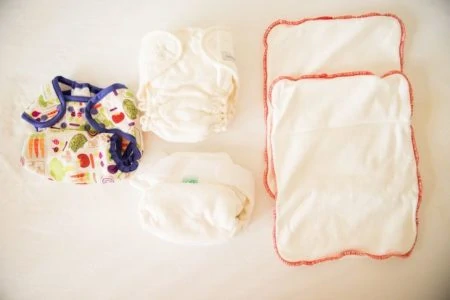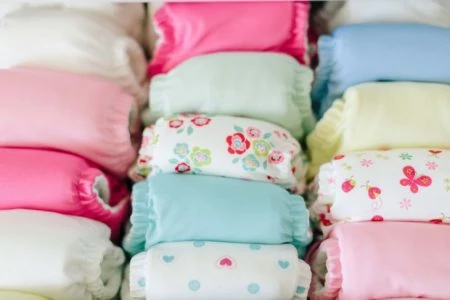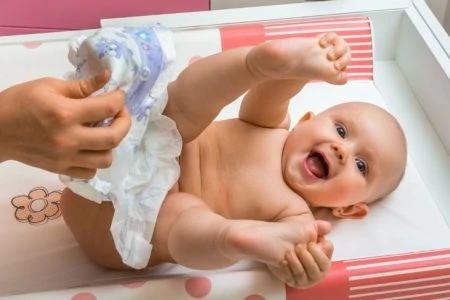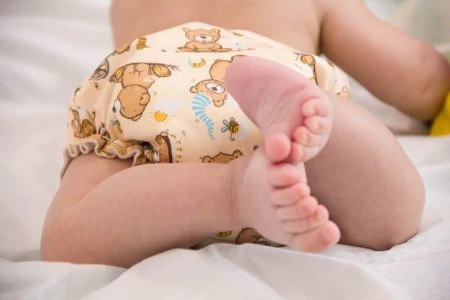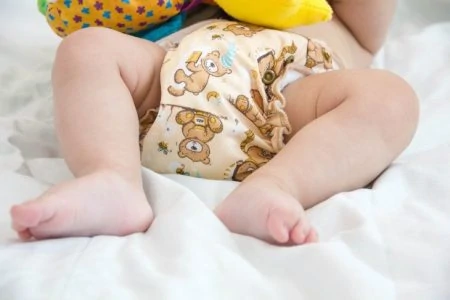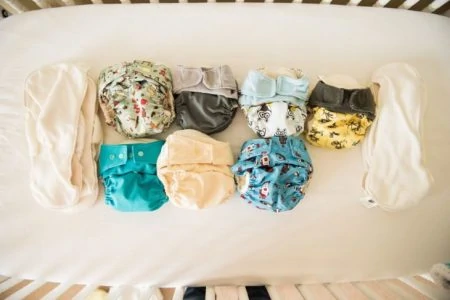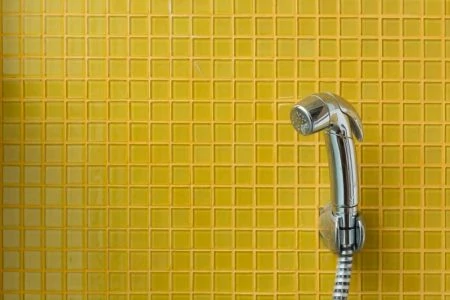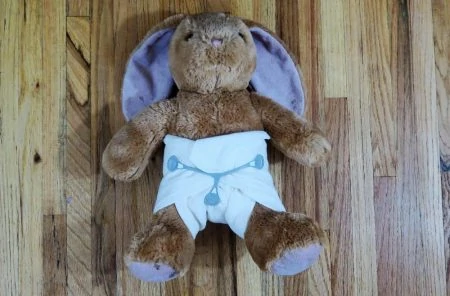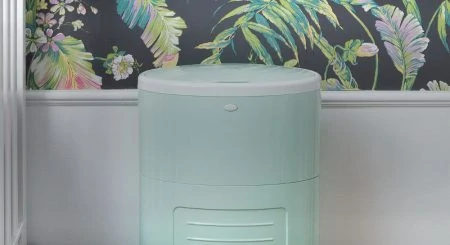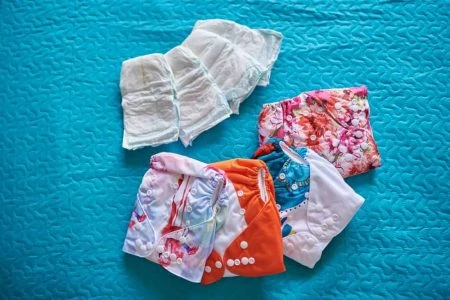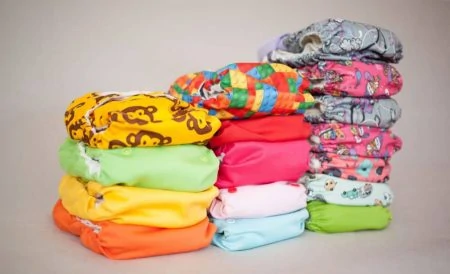Thinking about switching to cloth diapers but terrified of the mess? You aren’t alone. Many parents worry that cloth diapering is complicated, gross, or time-consuming.
The reality is quite different. Modern cloth diapers are just as easy to use as disposables, but they come with better prints, massive cost savings, and a much smaller environmental impact. We used cloth diapers for years, saved thousands of dollars, and kept mountains of waste out of landfills.
We are here to simplify the process. From the different types of diapers to the wash routine, here is everything you need to know about how to use cloth diapers.
Key Takeaways
- Save Money: Cloth diapering can save you over $1,000 per child compared to disposable diapers, especially if you use them for multiple children.
- Know Your Types: There are several styles, including flats, prefolds, pockets, fitteds, all-in-ones (AIOs), and all-in-twos (AI2s).
- Essential Gear: Beyond the diapers, you need waterproof covers, wet bags for storage, and cloth-safe diaper cream.
- Simple Wash Routine: Cleaning is easy; dump solids, run a pre-wash cycle, run a heavy duty main wash, and dry.
Reasons to Use Cloth Diapers
Why are so many parents ditching disposables for reusable options? Let’s look at the benefits.
1. Cost-Effective
The upfront cost of cloth diapers looks scary, but the long-term math works in your favor. Depending on the system you choose (flats vs. all-in-ones), a full stash costs between $200 and $800.
Compare that to disposables. If your baby potty trains at age two, you will spend roughly $1,350 on disposable diapers. That creates immediate savings of $500 or more.
The savings skyrocket with your second child. You already own the diapers, so you might only spend $50 to $100 on fresh wipes or a few cute new prints. For two children, you could save well over $2,000.
2. Eco-Friendly
Cloth diapers help the planet, despite the water required to wash them.
Consider the landfill impact: It takes an estimated 500 years for a disposable diaper to decompose (1). With 20 billion disposables entering landfills annually, the waste adds up fast.
Manufacturing disposables also consumes roughly 200,000 trees annually in the US alone. While washing cloth diapers uses water (about 10,000 gallons from birth to potty training), the environmental footprint is significantly lower than the production and waste cycle of single-use plastics.
Different Types of Cloth Diapers
Forget the rubber pants and safety pins your grandma used. Modern cloth diapers are high-tech, adorable, and efficient.
1. Flats
These are the “old school” diapers. A flat is a single, large layer of fabric (usually cotton or bamboo) that you fold into a diaper shape. They are the most affordable option and easiest to clean.
You can even use flour sack towels, receiving blankets, or t-shirts as flats. Since they are just fabric, they require a waterproof cover and a fastener (like a Snappi) to stay on.
- Pros: Extremely cheap, dry very fast, fit any size baby.
- Cons: Require folding every time, need a separate waterproof cover.
2. Prefolds
Prefolds are similar to flats but have extra layers of fabric sewn into the center panel for better absorbency. They are rectangular and require less complex folding than flats.
Like flats, you secure them with a fastener and place a waterproof cover on top. They are a favorite for newborns because they are inexpensive and contain “explosions” well.
Protection Tip
3. Pockets
Pocket diapers are the most popular modern style. They consist of a waterproof outer layer (PUL) and a soft inner lining (usually fleece or suede cloth) that stays dry against the baby’s skin.
There is an opening, or “pocket,” between the layers where you stuff an absorbent insert.
- Pros: Customizable absorbency, easy to put on (like a disposable), stay-dry feel.
- Cons: You must stuff them before use and remove inserts before washing.
4. All-in-Ones (AIOs)
All-in-Ones are the closest thing to a disposable. The absorbent layers are sewn directly into the waterproof shell. There is no folding, stuffing, or matching parts. You put it on, take it off, and wash the whole thing.
- Pros: Most convenient, daycare-friendly, easy for grandparents.
- Cons: Most expensive option, take longer to dry.
5. All-in-Twos (AI2s)
This system, also known as hybrid diapers, separates the cover from the absorbent insert. You snap or lay the insert into the cover.
When the baby wets, you swap out the wet insert and reuse the cover. This means you need fewer expensive covers and carry less bulk in your diaper bag. You can often use disposable inserts with these shells for travel.
6. Fitteds
Fitted diapers are made entirely of absorbent material (cotton, hemp, or bamboo) with elastic around the legs and waist. They look like a finished diaper but are not waterproof. You must wear a cover over them.
Because the entire diaper absorbs liquid, fitteds are the gold standard for nighttime use or heavy wetters.
Cloth Diaper Accessories
Building a stash requires more than just the diapers. Here are the tools that make the job easier.
1. Covers
If you use flats, prefolds, or fitteds, you need covers. These are waterproof shells, usually made of PUL (polyurethane laminate) or wool. They come in “sized” options (perfect fit) or “one-size” options (adjustable snaps).
2. Diaper Fasteners
Skip the sharp safety pins. Modern parents use silicone fasteners like Snappis or Boingos. These T-shaped devices grip the fabric of prefolds or flats to hold them securely on the baby.
3. Wet Bags
A wet bag is a waterproof, zippered sack for storing dirty diapers. You will want a large one for your laundry pail at home and smaller, portable ones for your diaper bag. They trap smells and moisture effectively.
4. Diaper Sprayer
This is a game-changer. A diaper sprayer is a handheld bidet attachment that hooks to your toilet. When your baby starts solid foods, use the sprayer to blast poop off the diaper and into the toilet before washing.
5. Cloth Wipes
If you are washing diapers, you might as well wash the wipes. Cloth wipes grab messes better than flimsy disposables. You can wet them with plain water or a simple homemade solution.
6. Cloth Wipe Solution
Many parents use plain water. If you want something more soothing, try this easy recipe:
- Two cups of water.
- One tablespoon fractionated coconut oil (for moisture).
- One tablespoon of Dr. Bronner’s unscented castile soap (for cleaning).
Mix in a spray bottle or pour directly over your wipes container.
How to Wash Cloth Diapers
The wash routine scares many parents, but it is actually just three steps: remove solids, pre-wash, and main wash.
First, you need a cloth-safe detergent. Tide powder is a popular favorite because it cleans heavily soiled laundry effectively. Avoid fabric softeners, as they coat the fibers and cause leaks.
- Step 1: Remove Solids. For breastfed babies, poop is water-soluble and can go straight into the wash. For formula or solid-food poop, plop or spray it into the toilet first.
- Step 2: Pre-Wash. Run a quick cycle with warm water and a small amount of detergent. This rinses away the bulk of the urine and waste.
- Step 3: Main Wash. Run a “Heavy Duty” or “Whites” cycle with hot water and the full amount of detergent. This deep cleans the diapers.
Once clean, you can line dry them or toss them in the dryer on low heat.
Cloth Diapering Mistakes to Avoid
1. Buying only one style
Every baby is built differently. A brand that works for your best friend might leak on your baby. Buy a small variety (a few pockets, a few prefolds, a few AIOs) to test the fit before committing to a huge stash.
2. Skipping the prep
New natural fibers (cotton, hemp, bamboo) contain natural oils that repel water. You must wash and dry them multiple times (3 to 5 times) before use to make them absorbent. If you skip this, the diaper will leak instantly.
3. Not stripping used diapers
Buying secondhand is brilliant for your budget, but you must sanitize them. “Stripping” removes mineral buildup, and a bleach soak kills bacteria. Use products like RLR or GroVia Mighty Bubbles followed by a bleach wash to reset the diapers.
4. Placing microfiber against skin
Microfiber is highly absorbent, but it is too aggressive for delicate skin. It pulls moisture so effectively that it dries out the skin, causing severe red rashes. Always ensure a layer of fleece or cotton sits between the microfiber insert and your baby’s bottom.
5. Using the wrong cream
Standard diaper creams often contain petroleum or cod liver oil. These ingredients create a waterproof barrier on the cloth that is nearly impossible to wash out. Use a “cloth-safe” cream (usually zinc-free or petroleum-free) or use a disposable liner if you need heavy-duty rash cream.
6. Having a stash that is too small
Newborns go through 10 to 12 diapers a day. If you want to wash every other day, you need at least 24 diapers. If you have too few, you will be forced to do laundry daily, which leads to burnout.
7. Soaking diapers (Wet Pailing)
In the past, parents soaked dirty diapers in a bucket of water. Do not do this. It creates a drowning hazard for toddlers and breeds bacteria and ammonia, which ruins the fabric. Store dirty diapers in a “dry pail” (an open basket or hanging wet bag) with plenty of airflow until wash day.
